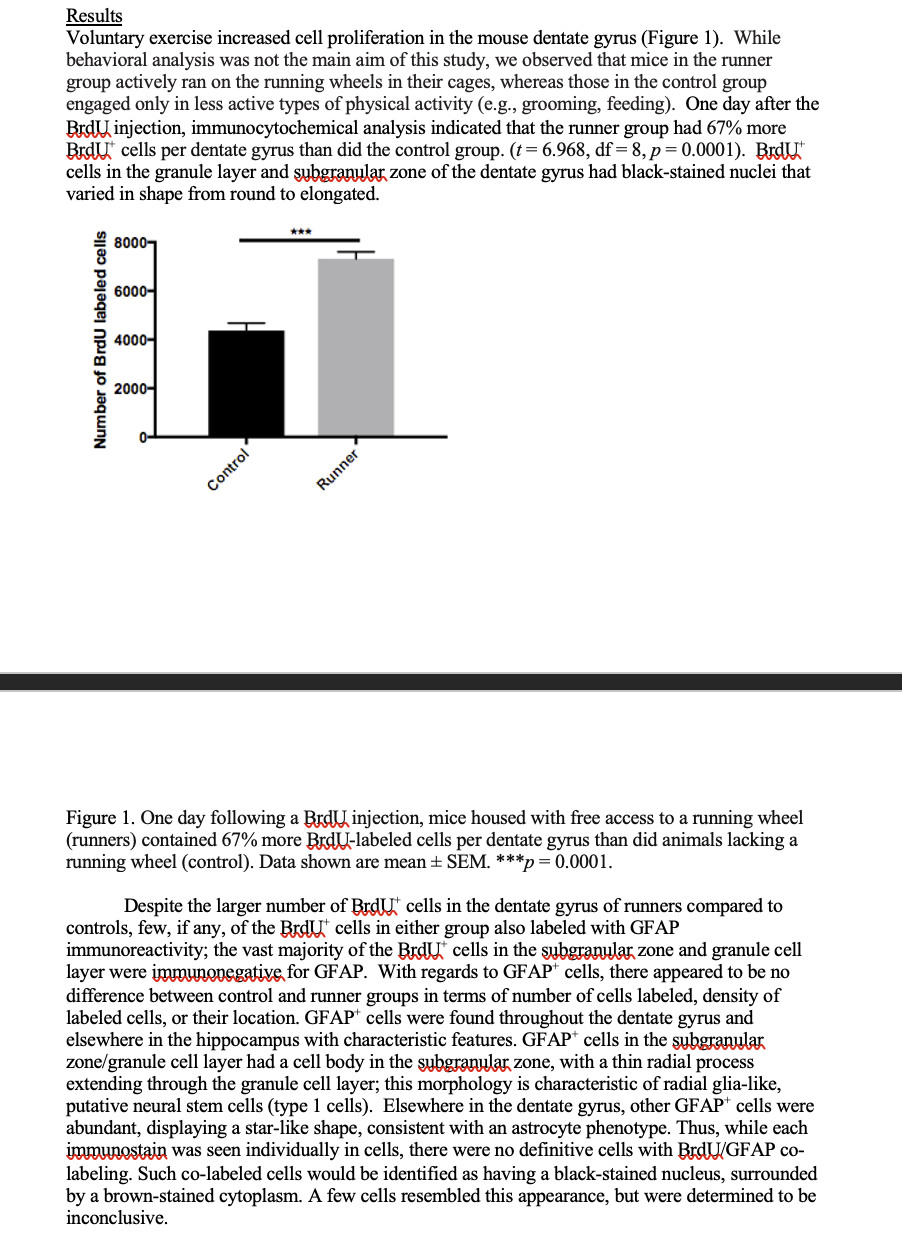Results Voluntary exercise increased cell proliferation in the mouse dentate gyrus (Figure 1). While behavioral analysis was not the main aim of this study, we observed that mice in the runner group actively ran on the running wheels in their cages, whereas those in the control group engaged only in less active types of physical activity (e.g., grooming, feeding). One day after the Brd injection, immunocytochemical analysis indicated that the runner group had 67% more Brd cells per dentate gyrus than did the control group. (= 6.968, df = 8, p = 0.0001). Brd cells in the granule layer and subgranular zone of the dentate gyrus had black-stained nuclei that varied in shape from round to elongated. 8000- *** 6000- Number of BrdU labeled cells 4000- 2000- Control Runner Figure 1. One day following a Brinjection, mice housed with free access to a running wheel (runners) contained 67% more BrdU-labeled cells per dentate gyrus than did animals lacking a running wheel (control). Data shown are mean ± SEM. ***p = 0.0001. Despite the larger number of BrdU cells in the dentate gyrus of runners compared to controls, few, if any, of the B cells in either group also labeled with GFAP immunoreactivity; the vast majority of the Bed cells in the subgranular zone and granule cell layer were immunonegative for GFAP. With regards to GFAP* cells, there appeared to be no difference between control and runner groups in terms of number of cells labeled, density of labeled cells, or their location. GFAP*+ cells were found throughout the dentate gyrus and elsewhere in the hippocampus with characteristic features. GFAP cells in the subgranular zone/granule cell layer had a cell body in the subgranular, zone, with a thin radial process extending through the granule cell layer, this morphology is characteristic of radial glia-like, putative neural stem cells (type 1 cells). Elsewhere in the dentate gyrus, other GFAP+ cells were abundant, displaying a star-like shape, consistent with an astrocyte phenotype. Thus, while each immunostain was seen individually in cells, there were no definitive cells with BrdU/GFAP co- labeling. Such co-labeled cells would be identified as having a black-stained nucleus, surrounded by a brown-stained cytoplasm. A few cells resembled this appearance, but were determined to be inconclusive.
interpret these results and explain these as detailed as possible
include an explanation of why the results demonstrate what they do and possible explanations for this

Trending now
This is a popular solution!
Step by step
Solved in 3 steps

could you explain a bit more what this sentences mean:
The information displayed demonstrates a significant increase in cell proliferation inside the dentate gyrus of mice that were locked in voluntary exercise compared to the control group. The use of 5-Bromo-2'-deoxyuridine (BrdU), a thymidine analog, permits the following of recently formed cells because it is incorporated into the DNA of dividing cells amid the S stage of the cell cycle. The immunocytochemical examination uncovered a 67% increase in BrdU-labeled cells within the running group, meaning upgraded neurogenesis, which is factually noteworthy as shown by the p-value of 0.0001.
The observation that the runner group effectively utilized the running wheels given in their cages relates to the increment in BrdU-labeled cells.

